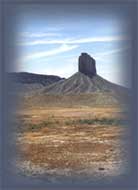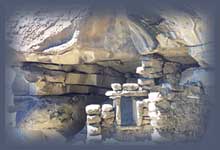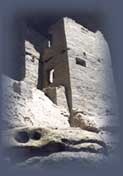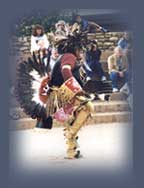 The drive to the Ute Mountain Tribal Park's cliff dwellings is not
comfortable. Nearly 40 miles of torturous, rutted, unpaved dirt and gravel
roads lie between the sites and Highway 160 in Towaoc,
Colorado in the southwestern corner of the state. Random rock slides
occasionally block the way, strewing ottoman-sized boulders across the roads
like fistfuls of Parcheesi dice. During the rainy months of July and August,
thick mud makes many of the sites inaccessible, even with a four-wheel drive.
The drive to the Ute Mountain Tribal Park's cliff dwellings is not
comfortable. Nearly 40 miles of torturous, rutted, unpaved dirt and gravel
roads lie between the sites and Highway 160 in Towaoc,
Colorado in the southwestern corner of the state. Random rock slides
occasionally block the way, strewing ottoman-sized boulders across the roads
like fistfuls of Parcheesi dice. During the rainy months of July and August,
thick mud makes many of the sites inaccessible, even with a four-wheel drive.
Hayes: "This was an old trail, it was like an old hunting trail, where they
would use that going up on horseback, and then back in the, probably in the
twenties or thirties they kinda widened it where it was just a single dirt
road, enough for a wagon to get up."
Rick Hayes is the guy to my left behind the wheel of a beat-up, old blue
Chevy pickup. Hayes is a tribal park guide and member of the Weeminuche band
of Utes, a tribe that once inhabited all of Colorado and parts of Utah,
which takes its name from the tribe. The Utes were the first western Indians
to obtain horses, or magic dogs as they called them, through trade or just
plain theft from the Spanish. A proud, warlike people, they were also among
the last of the western Indian tribes to be herded onto a reservation.
Hayes: "They were called the people of the shining mountains, 'cause of the
Colorado Rockies and they were about the only tribe that really called that
home. And they lived there for thousands of years."
According to tradition, the Utes are descended from the Anasazi, or ancient
ones, who lived more than a thousand years ago throughout the four-corners
region where Colorado, Utah, Arizona and New Mexico converge. A
sophisticated agricultural society, the Anasazi left behind many fine
examples of rock paintings, pottery and basket-weaving...but their most
famous legacy has to be the remarkable sandstone cliff dwellings they built
between 600 and 1300 A.D in alcoves high above the canyon floors of their
desert home.

Hayes: "We walk from here."
It's a harsh and barren yet colorful environment...a rocky, sun-scorched
palette of gray cliffs and brick red buttes, studded with prickly bouquets
of sagebrush, juniper and hardy ponderosa pine. No one lives here now except
scorpions and rattlesnakes, coyotes and cougars.
But after a good half an hour and a thousand feet or so of scrambling up a
steep cliff face, the evidence is clear that people did live here once, and
lived quite well.
Hayes: "This site here is called Two-Story House. When this was built, they
considered this the golden years, uh, from about 10 A.D. all the way up to
the 1300s. They had corn, beans, squash, a lot of cotton. Everything was
going good for them."
 Archaeologists and anthropologists have long debated why the Anasazi
migrated from the canyons and built these impressive, apartment-like
complexes high in the cliffs. Some say it was a defensive strategy;
others have suggested that those who lived here were members of an elite
class. Park guide Rick Hayes believes such theories are too complicated and
says the reasons the Anasazi moved to the cliffs are fairly obvious.
Archaeologists and anthropologists have long debated why the Anasazi
migrated from the canyons and built these impressive, apartment-like
complexes high in the cliffs. Some say it was a defensive strategy;
others have suggested that those who lived here were members of an elite
class. Park guide Rick Hayes believes such theories are too complicated and
says the reasons the Anasazi moved to the cliffs are fairly obvious.
Hayes: "It kept you out of the rain, it kept you out of the snow, kept the
wind out. This is a good grain storage area, plus I think they liked the
view [laughs]."
 Much of the park's 125,000 acres are visible from these steep vantage
points, a dry, dusty, expanse, bisected by the brown, silty waters of the
Mancos River, land that was once home to as many as 50,000 Anasazi. It's
estimated that there are some 20,000 ruins here, twice as many as at nearby
Mesa Verde National Park. There, tourists throng every day to visit cliff
dwellings that have been restored and made easily accessible by paved
pathways and parking lots, not to mention the convenience of concession
stands and gift shops that typically go hand in hand with major tourist
attractions. But at the Ute Mountain Tribal Park, there are no parking lots,
no conveniences, no food, no water. The closest thing to cafeterias are
the empty granaries where the Anasazi stored their corn or the fractured
remains of pottery that still litter the sites, untouched perhaps since the
day they were left there by a careless squaw or rambunctious child.
Much of the park's 125,000 acres are visible from these steep vantage
points, a dry, dusty, expanse, bisected by the brown, silty waters of the
Mancos River, land that was once home to as many as 50,000 Anasazi. It's
estimated that there are some 20,000 ruins here, twice as many as at nearby
Mesa Verde National Park. There, tourists throng every day to visit cliff
dwellings that have been restored and made easily accessible by paved
pathways and parking lots, not to mention the convenience of concession
stands and gift shops that typically go hand in hand with major tourist
attractions. But at the Ute Mountain Tribal Park, there are no parking lots,
no conveniences, no food, no water. The closest thing to cafeterias are
the empty granaries where the Anasazi stored their corn or the fractured
remains of pottery that still litter the sites, untouched perhaps since the
day they were left there by a careless squaw or rambunctious child.
Around 1300 A.D., the Anasazi abandoned their cliffside homes and
disappeared as mysteriously as they arrived in these canyons thirteen
centuries earlier. Historians believe that drought may have driven them
away, while the Hopis of Arizona, who also claim descent from the cliff
dwellers, say that the Anasazi fulfilled a prophecy that condemned them to
centuries of wandering before returning to the spirit world whence they
came.
The Hopi, as well as the Utes, consider these sites, and the past they honor
in song, as sacred places and for this reason no one is allowed to visit
them or the park unless accompanied by a Ute guide. Yet even before there
was a park, the Utes were taught to treat these ruins with reverence.
Hayes: "Cause there are spirits up here, I believe, you know up here, you
just gotta respect them and they'll respect you."
 Though the Utes run a gambling casino just up the road and do peddle a few
postcards and T-shirts at the park's modest visitors center, the cliff
dwellings here on their reservation are a refreshing island of dignity amid
a sea of trading posts and truck stops, all hawking the same tired
assortment of so-called authentic Indian beadwork, moccasins and pottery.
While less well known than many of their neighboring tribes -- the Sioux,
the Navajo, Arapahoe, and Shoshone -- the Utes, with their proud history
of defending their culture, seem appropriate caretakers of these places --
the guardians, as it were, of a lost civilization.
Though the Utes run a gambling casino just up the road and do peddle a few
postcards and T-shirts at the park's modest visitors center, the cliff
dwellings here on their reservation are a refreshing island of dignity amid
a sea of trading posts and truck stops, all hawking the same tired
assortment of so-called authentic Indian beadwork, moccasins and pottery.
While less well known than many of their neighboring tribes -- the Sioux,
the Navajo, Arapahoe, and Shoshone -- the Utes, with their proud history
of defending their culture, seem appropriate caretakers of these places --
the guardians, as it were, of a lost civilization.
At the Ute Mountain Utes Tribal Reservation in Tawaoc,
Colorado, I'm Tom Verde for The Savvy Traveler.
|
Savvy Resources for Anasazi Cliff Dwellings
Ute Mountain Tribal Park
Essential info: Water and food is not available in the park. Bring plenty of drinking water, lunch for the all day trips, insect repellent, sun screen, a hat, and sturdy shoes. Have a full tank of gasoline. No dogs allowed. No professional photography.
- Full day treks (8:30 a.m.-4:00 p.m.) in the Ute Mountain Tribal Park are $30 per person (12 people or more within a group, $17 per person).
- Less strenuous half day visits (8:30 a.m.-12:30 p.m.) are $17 per person.
- Special tours to remote sections of the park are $60 per person (minimum of four people, 5.6 miles of hiking and climbing on original ancestral pueblo trails).
- Camping (primitive facilities) available in the park: $10 per vehicle per day.
- School discount rates available.
To make arrangements to visit the Ute Mountain Tribal Park, call or write:
Ute Mountain Tribal Park
Towaoc, CO 81334
800-847-5485
E-mail: utepark@fone.net
SW Colorado's Ute Mountain Tribal Park info page
http://www.swcolo.org/
For more information on Anasazi culture and the Cortez area:
Cortez Cultural Center
25 North Market Street
Cortez, CO 81321
970-565-1151
E-mail: cultural@fone.net
Web: www.cortezculturalcenter.org
Cortez/Dolores/Mesa Verde Country
Visitors Information Bureau
PO Drawer HH
Cortez, CO 81321
800-253-1616
Web: www.swcolo.org
Cortez Visitor's Center
808 East Main
Cortez, CO 81321
303-565-3414
For information on Mesa Verde and visiting Mesa Verde National Park:
Mesa Verde National Park
PO Box 8
Mesa Verde National Park, CO 81330
Phone: 970-529-4465
TDD: 970-529-4633
Tours: 970-529-4475
Web: www.mesa.verde.national-park.com/
Tourist information for Colorado:
Colorado Tourism Board
1-800-COLORADO (800-265-6723)
Web: www.colorado.com
American Airlines serves Durango, one of the nearest airports to the Ute Mountain Tribal Park and Mesa Verde National Park, on board American Eagle. To make reservations, call American at 800-433-7300 or visit their web site at www.aa.com.
Music in this story by:
Norman Lopez (flute)
Hay-Yo Production
PO Box 116
Towaoc, CO 81334
E-mail: Menahen@excite.com
The Manning Family Dancers
(Native American song and dance)
PO Box 253
Towaoc, CO 81334
970-565-7354/8548
Suggested Reading:
People of the Shining Mountains
by Charles S. Marsh
Pruett Publishing Company (Boulder, CO)
A concise and readable history of the Utes of Colorado from the earliest times to the present. Available from amazon.com.

|







